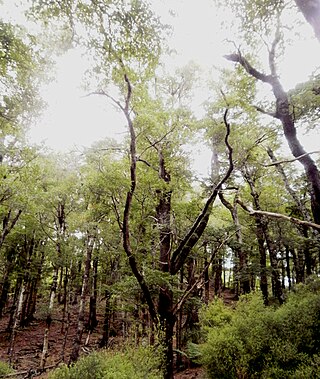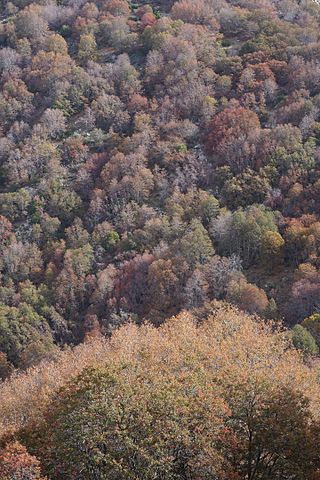
Nothofagus, also known as the southern beeches, is a genus of 43 species of trees and shrubs native to the Southern Hemisphere in southern South America and east and southeast Australia, New Zealand, New Guinea, and New Caledonia. The species are ecological dominants in many temperate forests in these regions. Some species are reportedly naturalised in Germany and Great Britain. The genus has a rich fossil record of leaves, cupules, and pollen, with fossils extending into the late Cretaceous period and occurring in Australia, New Zealand, Antarctica, and South America.

Nothofagus antarctica is a deciduous tree or shrub native to southern Chile and Argentina from about 36°S to Tierra del Fuego, where it grows mainly in the diminishing temperate rainforest.

Nothofagus cunninghamii, commonly known as myrtle beech or Tasmanian myrtle, is the dominant species of cool temperate rainforests in Tasmania and Southern Victoria. It has low fire resistance and grows best in partial shade conditions.

Nothofagus gunnii, the tanglefoot or deciduous beech, is a deciduous shrub or small tree endemic to the highlands of Tasmania, Australia. It was described in 1847 by R.C Gunn N. gunnii is a small woody tree with a shrubby appearance known to grow up to 8 metres (26 ft). It lives only on mountains due to temperature limitations within the Tasmanian maritime climate and mainly grows at altitudes greater than 800 metres (2,600 ft) above sea level. It grows in alpine and sub-alpine regions in the central portions of the island. Though capable of reaching the size of a small tree, it is most common as a thick shrub or woody ground cover, hence its common name of "tanglefoot".

Nothofagus dombeyi, Dombey's beech, coigue, coihue or coigüe is a tree species native to southern Chile and the Andean parts of Argentine Patagonia. It is a fast-growing species that can live in a wide range of climatic conditions, and forms dense forests. It is cultivated for its timber, and as an ornamental subject.

Gomortega keule is a species of tree endemic to Chile. It is the sole species of the genus Gomortega and, according to the APG IV system of 2016, of the monotypic family Gomortegaceae, assigned to the order Laurales in the clade magnoliids.

Nothofagus fusca, commonly known as red beech is a species of southern beech, endemic to New Zealand, occurring on both the North and South Island. It is generally found on lower hills and inland valley floors where soil is fertile and well drained. In New Zealand the species is called Fuscospora fusca.

Nothofagus betuloides, Magellan's beech or guindo, is a tree native to southern Patagonia.

Nothofagus truncata, or hard beech, is a species of tree endemic to New Zealand. Its common name derives from the fact that the timber has a high silica content, making it tough and difficult to saw. Hard beech is a tree up to 30m tall occurring in lowland and lower montane forest from latitude 35°S to 42°30'S, that is, from the north of the North Island southwards to Marlborough and south Westland in the South Island. In Taranaki it forms almost pure stands on the rugged sandstone country there and is partially deciduous, dropping many of its leaves at the end of the winter. N. truncata became known as Fuscospora truncata after 2013 in New Zealand.

Nothofagus solandri, commonly called black beech, is species of tree endemic to New Zealand. Black beech occurs on both the North and the South Island at low elevations up to the mountains. It is also known as Nothofagus solandri var.solandri. In New Zealand the taxon is often called Fuscospora solandri.

Nothofagus alessandrii, the ruil, is a species of plant in the family Nothofagaceae, commonly known as the southern beeches. It is endemic to Chile, occurring chiefly in the Chilean matorral ecoregion. It is threatened by habitat loss. The species is protected within Los Ruiles National Reserve.
Nothofagus baumanniae is a species of tree in the family Nothofagaceae. It is endemic to New Caledonia, where it grows in forests at high elevations. The species is threatened by fires, nickel mining and climate change.
Nothofagus discoidea is a species of plant in the family Nothofagaceae. It is endemic to New Caledonia.
Nothofagus nuda is a species of plant in the family Nothofagaceae. It is endemic to Papua New Guinea. It is threatened by habitat loss.
Nothofagus stylosa is a species of plant in the family Nothofagaceae. It is endemic to West Papua (Indonesia). It is a Critically Endangered species threatened by habitat loss.
Nothofagus womersleyi is a species of plant in the family Nothofagaceae. It is endemic to Kebar Valley on the Vogelkop Peninsula in West Papua (Indonesia). It is a Critically Endangered species threatened by habitat loss.

Nothofagus nitida is an evergreen tree, native to southern Chile and Argentina. It is found from latitude 40° S to Última Esperanza.

Nothofagus cliffortioides, commonly called mountain beech, is a species of Southern beech tree and is endemic to New Zealand. Mountain beech grows in mountainous regions at high elevations. In New Zealand the taxon is called Fuscospora cliffortioides. Nothofagus cliffortioides occupies a wider range of habitat than any other New Zealand tree species and it shows a corresponding range of life form, seeding habits, regenerative patterns, growth habits, growth rates, stand replacement and mortality patterns.

Nothofagus macrocarpa, commonly known as roble de Santiago or Santiago's oak, is a deciduous tree in the Nothofagaceae family that is endemic to the mountains of central Chile.
Nothofagus grandis is a species of tree in the family Nothofagaceae. It is endemic to New Guinea. It grows in lower montane rain forests from 900 to 1,500 meters elevation.













